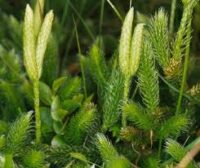Portrait: Lycopodium
Lycopodium was prehistorically a very large tree on Earth. These days it is a very small ground cover moss that only stands tall for purposes of reproduction.

It is named for Lyc (wolf) and podium (foot) as the moss resembles a wolf paw.

It is little wonder that following this description the medicine is used for the classic “small man” syndrome where one feels he ought to be bigger than he is and will bully those who are weaker than himself (or herself) although in females it can also manifest as low self -esteem. This medicine has been ‘diminished’ or ‘overlooked’.
The physical picture in humans with early greying of hair, the furrowed brow and spindly legs and weak stomach musculature are far less reliable indicators in the animal patient, so we look more to the mental picture and functional disturbances of digestion and liver function.
I have used this medicine for many cases over the years and perhaps the most memorable was a young Border Collie male with performance anxiety over his first mating experience. He was trying too hard and had performance anxiety, unable to attain the goal and I recommended a day off and a dose of Lycopodium200. The following week a proud owner reported success and joked that he would like some of that for his wife (little realising that the female equivalent in that application is more likely to be Sepia). Nine weeks later we had beautiful puppies.
As one of the three in the triad Calc/Lyc/Sulph, Lycopodium is also a Polychrest and will appear in a large number of rubrics when repertorising a case.
It is helpful therefore to memorise some keynotes of this medicine such as the 4-8pm time frame that is when symptoms seem to appear or be worse. Symptoms also classically start on the right side of the body and then move to the left in the course of disease.
We often speak of the Lycopodium German Shepherd given that this is a breed that is usually required to stand up and be the boss, be intelligent and confident and reliable when in fact the opposite is more often the case with poor choice of breeding stock, conformational disempowerment and inadequate socialisation.
The Lycopodium Shepherd is nervous, spindly, has poor digestion and acts like a bully in an unpredictable and inappropriate manner. We have all seen these dogs and Lycopodium can restore them to proper functioning and make them safer.

I realised early on in my homeopathy career that there are many similarities in the medicines and it can be hard to differentiate them. The system of kingdoms in homeopathy is often employed to help this differentiation.
These are mineral, vegetable/plant, or animal source. This led me to discover that many plants have high levels of certain minerals (as do we all) and why Lyc will often look similar to both Silica and Sulphur. There is a lot of Silica in Lycopodium which can account for the lack or loss of confidence in both, but I’m pretty sure a Lycopodium dog is more likely to bite you whereas a Silica one never has in my personal experience. I may have met a Lycopodium cat today because I was considering using Silica and it bit me quite deliberately on the finger because it was telling me to leave it alone and I was not listening to it and it wanted its own way. This cat has lack of capacity and chronic constipation so Lyc may be a good choice given that there is an element of fear appearing as malice. One of the most difficult things in determining the simillimum (correct medicine) is accurately identifying the mental picture or motivation of the animal. This nasty grumpy cat that bit me has been taking NuxVom for constipation and they are angry. NitAc is very deliberately nasty and harbour grudges so we often have to rely on the other symptoms to select the most appropriate medicine.

I also find that Lyc looks often like Lachesis too and these can be used interchangeably if other symptoms fit well.
The main difference with Lach is that it is usually very confident….rarely lacking… and in hindsight it may be the arrogance that is common to both which may in fact be more like Sulphur than Lyc. Both Lach and Sulph also tend also to run hot whereas Lyc is much less so and even chilly.
Without harping too much on the bully theme, it remains the main keynote for my prescription of Lycopodium. It also has affinity for the liver so it is a major remedy for digestive disturbances and constipation cases. As a first aid for constipation however I have found Nux vom in low potency to be more effective in most instances as both remedies have liver affinity.
I think I have been underutilising Lyc for dental/teeth pain, painful haemorrhoids and right sided sciatic pain but I try to find more symptoms in a case before prescribing a polychrest for a one-sided case. Also many symptoms are more difficult to define in animal patients. The sciatic pain is also Carduus Marianus (St Mary’s Thistle) which is another major liver remedy so it is easy to demonstrate the connectedness and comparative materia medica in these medicines as we explore the pharmacology and doctrine of signatures.
A keynote for Lycopodium urinary cases is red sediment/sand in the urine and painful urination so in well selected cases it has been used for FLUTD

A Lycopodium cat can be a urine sprayer if there is struvite crystalluria or history of FLUTD or often Lach or Staphysagria if it is mostly attributable to mental/behavioural aetiology. These cats will often all spray or defecate in front of their owners to get the message across.
It is often interesting to try to feel what the case elicits in yourself as an owner or practitioner. The owner is going to be more connected and less objective but the practitioner may have a certain affinity or identity for particular medicines based on how they make you respond to them. Owners can often be the same medicine as their pets.
Personally I often find Pulsatilla annoying perhaps because of them being sooky and cuddly, am largely indifferent to Lycopodium, amused and quite fond of Silica, get absolutely nothing from the boring/bland Thuja, am very impressed by Lachesis and quite admiring of them. I am wary of young Arsenicum and feel sorry for the older and often feel very agitated by Phosphorus but they can also make me smile as they do so themselves. Nat mur will often make me feel sad but a Nat mur state can also make the animal very angry as consolation aggravates. I will cover all of these in other postings if I have not already linked them. I have also noticed that the further out of balance these animals are then the more extreme the feeling given off.
This of course says as much about me as it does about the medicines themselves but over time we can learn to determine our individual characteristic responses that can help to differentiate our individual keys to remedy selection. It by no means reflects my overall opinion of the animal, it is merely another clue to remedy selection.
Without a doubt my regular practice of meditation assists me to ‘receive’ these cases as it hinges upon openly listening to the animal.
They are always glad to have someone who can hear them and sometimes they are very surprised when they discover you can.
